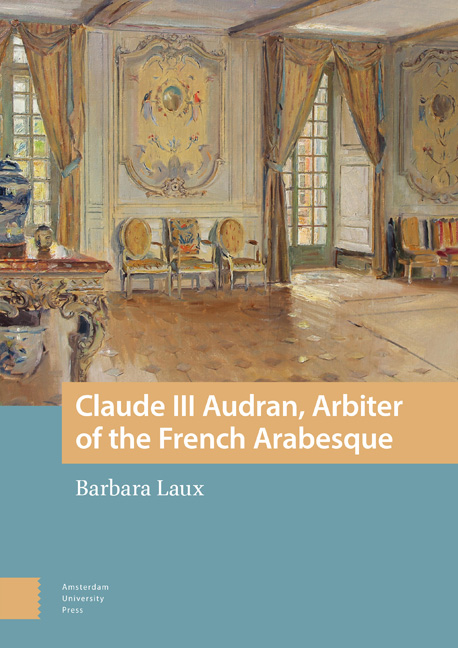Book contents
- Frontmatter
- Contents
- List of Illustrations
- Acknowledgements
- Introduction
- 1 Biography of Claude III Audran (1658–1734)
- 2 The French Arabesque as an Art Form, Audran as Master Ornamentalist , and His Initial Commissioned Works
- 3 Claude III Audran and Jean de La Fontaine’s Fables: Maintaining the Social Hierarchy
- 4 Attracting New Patrons in the Eighteenth Century
- 5 Claude III Audran’s Competitors and His Legacies
- Color Plates
- Appendix
- Bibliography
- Index
1 - Biography of Claude III Audran (1658–1734)
Published online by Cambridge University Press: 08 May 2024
- Frontmatter
- Contents
- List of Illustrations
- Acknowledgements
- Introduction
- 1 Biography of Claude III Audran (1658–1734)
- 2 The French Arabesque as an Art Form, Audran as Master Ornamentalist , and His Initial Commissioned Works
- 3 Claude III Audran and Jean de La Fontaine’s Fables: Maintaining the Social Hierarchy
- 4 Attracting New Patrons in the Eighteenth Century
- 5 Claude III Audran’s Competitors and His Legacies
- Color Plates
- Appendix
- Bibliography
- Index
Summary
Abstract
This chapter relates the known facts of Claude III Audran's life. Beginning with Audran's family background in his birthplace Lyon, it continues to discuss his training in Paris. He became a guild master in 1692. Soon afterwards, he found employment at the Bâtiments du Roi, the king's building department. During Audran's training, the Académie royale de peinture et de sculpture sought to set itself apart from the Guild. Audran, however, was probably forced to join the Maîtrise to the ongoing financial deficits of the crown. After his reception as a Guild maître, he circumvented Guild restrictions by subcontracting young artists. Audran's early commissions attracted elite clientele and proved his expertise. Jules-Hardouin Mansart commissioned him to work at the Ménagerie at Versailles.
Keywords: Guild; Académie royale de peinture et de sculpture; Gobelins manufactory; Maître/Maîtrise; arabesque
A red chalk drawing completed by Jean-Antoine Watteau (1684–1721) dated 1709 may be the only known image of Claude III Audran. Although the identification of the sitter has been debated, Watteau worked as Audran's assistant for several years, and the drawing shows the subject devising the sort of arabesque design for which Audran was known. Watteau's sitter, seen in profile, sits on a cushioned stool, the luxuriousness of which, along with the sitter's formal attire—coat, breeches, and a periwig—would indicate the level of prestige Audran had attained by this date.
The small size of this drawing (7-15/16 by 5-5/16 inches) and the fact that there are no known portraits of Audran to which it might be compared correspond to the paucity of biographical information available on this artist. In 1906, Pierre Marcel, in his La peinture française au début du dix-huitième siècle, 1690–1721, noted the regrettable absence of details regarding Audran. Given these limitations, this chapter relates known facts drawn from previous scholarship and primary materials. From these sources, it is possible to piece together Audran's life and to begin to explain his career.
The biography begins with Audran's family background and training. The second part starts when Audran embarks on his independent career as a master craftsman in the 1690s, and the third section relates to Audran's later career following the reign of Louis XIV
- Type
- Chapter
- Information
- Claude III Audran, Arbiter of the French Arabesque , pp. 31 - 68Publisher: Amsterdam University PressPrint publication year: 2024

